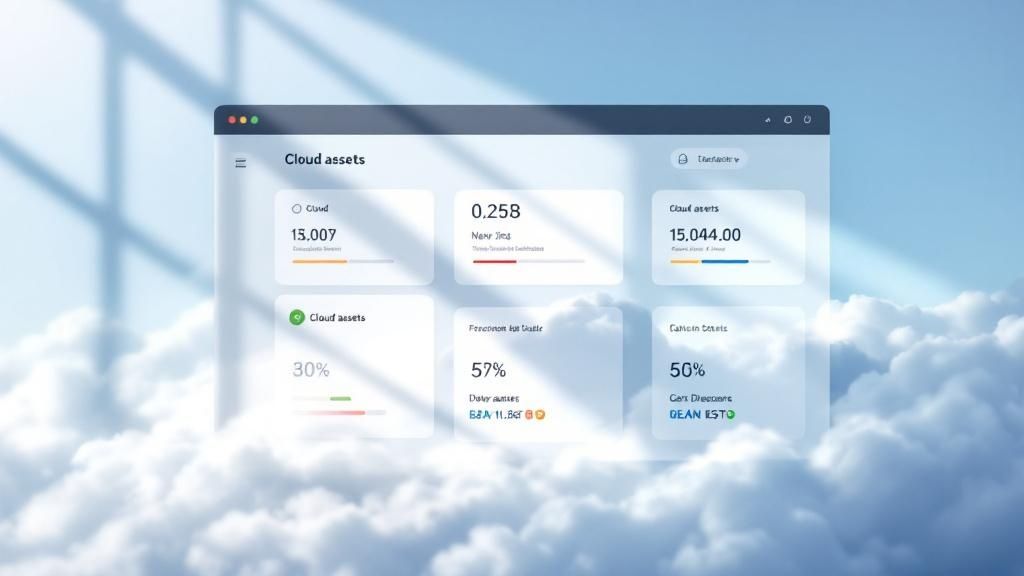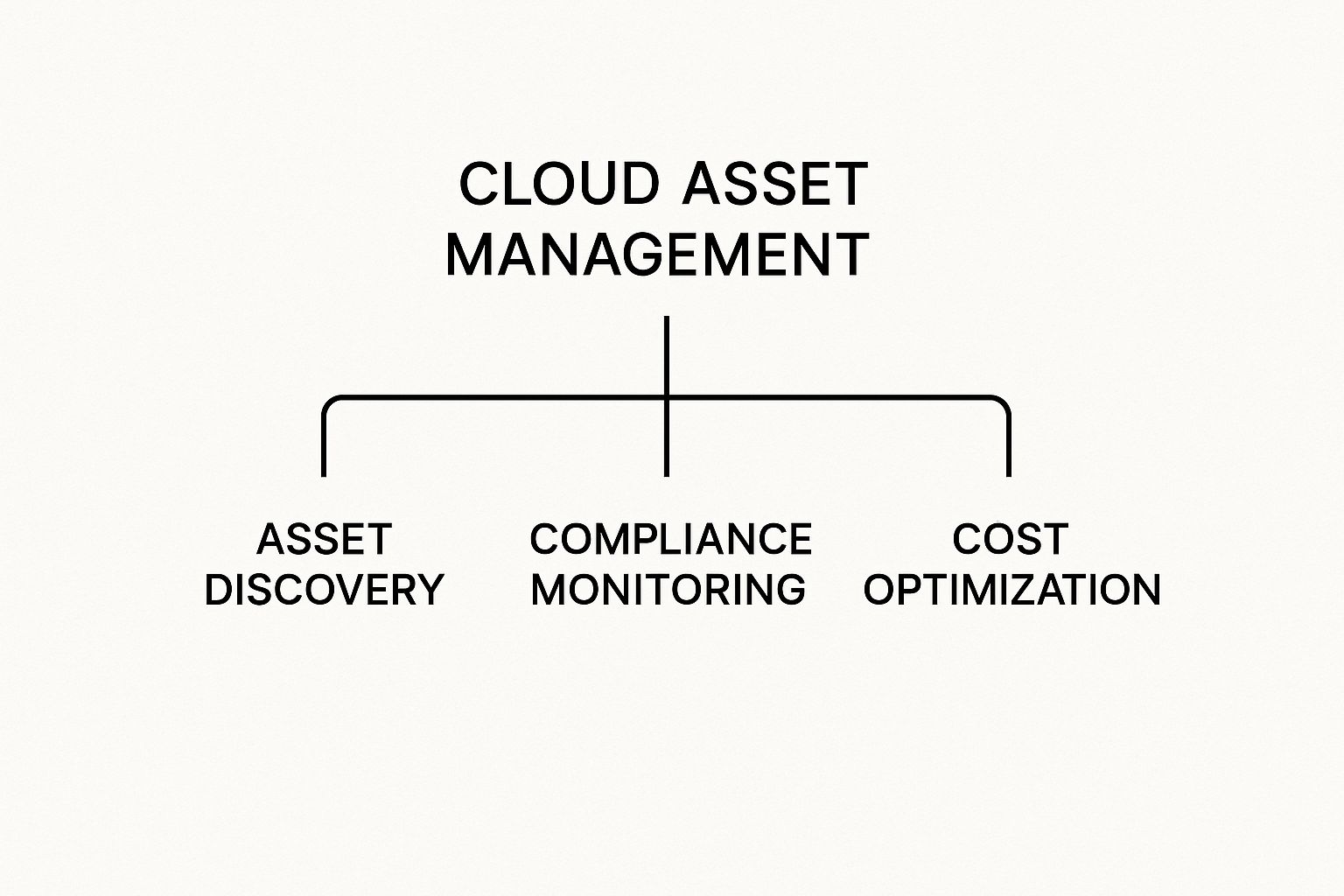Physical Address
304 North Cardinal St.
Dorchester Center, MA 02124
Physical Address
304 North Cardinal St.
Dorchester Center, MA 02124

Learn how cloud asset management boosts security, cuts costs, and maximizes resource efficiency. Discover strategies and tools today!
Let's be honest, trying to keep track of everything your business uses in the cloud can feel like managing a massive, invisible warehouse where new shelves and products appear and disappear every single minute, often across different countries. It's chaotic. That’s the reality of running on platforms like AWS, Azure, or Google Cloud without a solid, global plan.
Cloud asset management is the framework that brings order to that chaos. It's more than just a digital inventory list; it’s the essential practice of tracking, managing, and optimizing every single resource your organization owns in the cloud, no matter where it's located. Think of it as the central nervous system for your global digital footprint, ensuring nothing gets lost, wasted, or left vulnerable. This isn't just a good idea—for any business serious about controlling costs, tightening security, and succeeding internationally, it’s non-negotiable.

This discipline is so critical because cloud environments are a completely different beast than the old on-premise data centers. Resources are dynamic and scalable. They can be spun up or down in minutes by anyone with the right permissions, often scattered across different geographic regions. Without a central system to see it all, things get out of hand—fast.
At its heart, cloud asset management tackles one fundamental challenge: maintaining control over a sprawling and constantly shifting global tech landscape. It's what helps you answer the tough business questions that are nearly impossible to address otherwise, especially when operating across borders.
A strong CAM strategy puts an end to some of the most common—and costly—cloud headaches:
This isn't just an IT function anymore; it's a core business necessity for global operations. To get a better sense of what this looks like in practice, let's break down the fundamental pillars of a good cloud asset management strategy.
A successful strategy is built on a few key pillars, each serving a specific purpose to give you complete visibility and control over your global assets.
| Pillar | Description | Primary Goal |
|---|---|---|
| Discovery | The automated process of continuously scanning your cloud environments to find and identify every single asset, from virtual machines to storage buckets. | To create a complete, real-time inventory and eliminate blind spots caused by "shadow IT." |
| Monitoring & Tracking | The ongoing observation of asset usage, performance, and configuration changes over their entire lifecycle. | To understand how resources are being used, detect anomalies, and track costs in real time. |
| Optimization | The practice of analyzing usage data to right-size resources, eliminate waste, and apply cost-saving measures like reserved instances. | To reduce cloud spending by ensuring you only pay for what you actually need and use. |
| Security & Compliance | The process of enforcing security policies, assessing configurations against compliance standards, and managing access controls for all assets. | To minimize security risks, prevent data breaches, and ensure you meet industry and regional regulatory requirements. |
| Governance | The creation and enforcement of rules and policies that dictate how cloud resources can be provisioned, used, and decommissioned. | To establish clear operational guardrails, maintain control, and ensure accountability across the organization. |
Each of these components works together to transform your cloud environment from a potential liability into a well-oiled machine.
This systematic approach is why the market is expanding so quickly. The growing reliance on the cloud has made efficient asset management a top priority for businesses worldwide.
The global cloud asset management market was valued at approximately USD 3.97 billion in 2023 and is projected to reach USD 10.34 billion by 2028, growing at a compound annual growth rate (CAGR) of 17.1%.
This explosive growth highlights a massive global shift. As businesses lean more heavily on the cloud, they need smarter ways to manage those investments. You can explore more data on this expanding market to see where the industry is headed. Ultimately, putting a robust cloud asset management strategy in place is the first step in turning your cloud spend from a source of anxiety into a powerful, cost-effective engine for growth.
Let's move beyond theory and talk about what a strong cloud asset management strategy actually does for a business. This isn't just about tidy digital housekeeping; it's about delivering tangible results that get an executive's attention—better financial health, tougher security, and the freedom to innovate without taking on unnecessary risks. For global companies, these benefits are magnified, enabling smarter international expansion.

Think of your cloud budget like a water pipe. Without careful oversight, tiny, unnoticed leaks can spring up everywhere. Individually, they're small, but together they add up to a serious drain. That's exactly what happens with unmanaged cloud resources.
One of the first and most powerful impacts you'll see from proper cloud asset management is a big drop in your monthly bill. Most companies are shocked to find they’re paying for "zombie assets"—forgotten test servers, unattached storage volumes, and other abandoned resources that just sit there, quietly racking up charges.
A complete inventory gives you a map to hunt down and shut off these phantom resources. And this isn't a one-and-done cleanup. It’s a continuous process that keeps your cloud spending lean. By rightsizing services that were given too much power and killing idle instances, we've seen organizations cut their cloud bills by up to 30% or even more.
By gaining full visibility into resource utilization, businesses can make data-driven decisions. This transforms cloud spending from an unpredictable operational expense into a well-managed and forecastable budget item, which is essential for effective conversion optimization per region.
This kind of control means you only pay for what you actually use. That frees up cash that can be put toward real growth and innovation instead of being thrown away. These principles are just as important for smaller operations, and you can learn more about building an efficient setup in our guide to cloud storage for small business.
Beyond the financial wins, a complete asset inventory is your most critical line of defense. It’s simple: you can’t protect what you can’t see. Unmanaged assets, often born from "shadow IT" where teams spin up their own tools, create massive security blind spots.
These rogue resources are almost never configured to meet company security standards, leaving them wide open to attack. Proper cloud asset management sweeps through your environment, finds every single resource, and brings it under your security umbrella where it belongs. This is a key part of technical SEO for international reach, as search engines favor secure sites.
This total oversight allows you to:
By shutting down these unauthorized backdoors, you build a much stronger security posture that protects sensitive data and keeps your customers' trust. This is the ultimate competitive advantage—the power to move fast and innovate while staying secure.
Creating a solid cloud asset management strategy isn't about buying a fancy tool and crossing your fingers. It's about building a disciplined, repeatable process that moves your team from reactive chaos to proactive control. A good framework gives you a clear roadmap to follow, especially when developing localized content and geo-targeted landing pages.
This whole process really comes down to four key pillars that build on each other. When you focus on Total Asset Discovery, Intelligent Categorization, Automated Governance, and Continuous Optimization, you can cut through the complexity and start seeing real results fast.
This diagram shows how these four functions are the foundation of a complete system.

As you can see, everything starts with discovery. You can’t optimize costs or monitor for compliance until you know what’s out there.
Let's be blunt: you can’t manage what you can’t see. The very first step is getting 100% visibility into every single asset across all your cloud accounts. This means you’ll need to combine the native tools from your cloud provider with third-party platforms to stitch together a single, complete inventory.
This complete inventory becomes your single source of truth—the map you'll use to navigate your entire cloud estate. Without it, you’re flying blind.
Once you can see everything, the next job is to understand what you're looking at. This is where intelligent categorization comes in. It’s all about applying meaningful labels, or tags, to every single resource. A simple but consistent tagging policy is what makes your inventory genuinely useful.
A strong tagging strategy allows you to filter, sort, and report on assets by project, owner, cost center, or environment. For international companies, adding a 'region' or 'country' tag is crucial for analyzing performance and costs on a local level. This context turns a simple list of resources into a powerful management tool.
If you’re just starting out, focus on these essential tags:
This level of organization is crucial for holding people accountable and getting your cost allocation right. Proper categorization also ensures that even personal projects are managed correctly, which is why it’s smart to have a clear policy for using personal cloud storage within the company.
With a neatly tagged inventory, you can finally start enforcing rules automatically. Automated governance uses your tags to apply security, compliance, and cost control policies without you having to lift a finger. Think of it as setting up digital guardrails for your cloud environment.
For example, you could create a rule that automatically flags any production database that doesn’t have encryption turned on. Or maybe you set up another rule to alert the finance team when a project's spending is on track to blow past its monthly forecast. This kind of automation cuts down on manual work and ensures your policies are applied consistently, 24/7, across all regions.
Finally, cloud asset management is not a one-and-done project; it’s a continuous cycle of improvement. This final pillar is all about regularly reviewing your asset data to find opportunities for optimization. This includes analyzing which content types drive global conversions and adjusting your asset allocation accordingly.
This means hunting for underutilized resources that can be downsized, finding idle "zombie assets" that can be shut down for good, and analyzing usage patterns to buy reserved instances for your predictable workloads. I’ve found that setting a quarterly review cadence is a great way to ensure your cloud environment stays efficient, secure, and cost-effective over the long haul.
Cloud asset management is getting a whole lot smarter, and artificial intelligence is the reason why. For years, managing cloud assets felt like a reactive chore—a constant cleanup operation to deal with waste after the fact. AI is flipping that script, turning asset management into a predictive, strategic part of the business, essential for any international keyword strategy.
Instead of just finding overspending after you get the bill, AI-powered systems can now anticipate what you’ll need, stop waste before it happens, and flag security risks before they turn into a real problem.
Think of it this way: a traditional asset management tool is like a rearview mirror. It’s useful for seeing what you’ve already passed, but it can’t tell you what’s coming. An AI-infused system is more like a GPS with live traffic updates. It shows you exactly where you are, predicts the traffic jams ahead, and suggests smarter, faster routes to get you where you’re going.
This predictive power is completely changing how companies handle their cloud resources. It's no surprise that the market for AI in asset management is exploding as businesses catch on. The market was valued at a cool USD 3.4 billion in 2024 and is projected to skyrocket to USD 21.7 billion by 2034, growing at an incredible rate of 24.2% each year. This boom is all thanks to AI's knack for optimizing resources and cutting down on human error. You can read the full research about AI's market impact to see the full picture.
The real magic of AI is its ability to automate the kind of complex decisions that once took entire teams of analysts to figure out. No more manually digging through mountains of usage reports. Machine learning algorithms can now chew through vast amounts of data in real-time and spit out insights you can actually use.
AI-powered cloud asset management can look at your past usage, current workloads, and even your business calendar to forecast future spending with stunning accuracy. This finally gives finance teams the predictable budget data they’ve always wanted, enabling smarter regional investments.
This intelligent automation makes a huge difference in a few key areas:
These abilities deliver a level of precision and proactivity that was just out of reach before. It’s also why having the right cloud collaboration tools is so important, as they enable teams to act on these AI-driven insights quickly. By bringing AI into the fold, organizations get a serious competitive edge, transforming their cloud environment into a hyper-efficient and secure operational powerhouse.
Let's be honest—even the most perfectly planned cloud asset management strategy is going to hit a few bumps in the road. Every organization I've worked with has faced hurdles on its cloud journey, from tangled technical issues to good old-fashioned human resistance. The trick is knowing how to anticipate and solve these problems before they completely derail your progress.
Successfully navigating these issues is what separates a program that delivers real value from one that just fizzles out. It’s all about tackling problems like multi-cloud madness, messy asset tags, and a lack of buy-in from your engineers with proven, practical solutions. For global companies, challenges like creating effective multilingual content can add another layer of complexity.

In my experience, inconsistent tagging is easily the most common—and most damaging—challenge of them all. When your tags are messy, incomplete, or applied differently across teams, your entire cloud inventory becomes unreliable. Forget about accurate cost allocation, security scans, or automation; it all falls apart.
The solution is to create a simple, mandatory tagging policy that’s easy for everyone to follow. This shouldn’t be a 50-page document nobody reads. It needs to be a clear, straightforward standard that engineering teams can build right into their daily workflows, making compliance the path of least resistance.
A tagging policy isn't about control; it's about context. Without consistent tags, your cloud inventory is just a list of names. With them, it becomes a powerful, searchable database that drives business decisions and supports strategic initiatives like backlink building in target regions by identifying regionally successful assets.
Trying to manage assets across AWS, Azure, and Google Cloud at the same time can be a massive headache. Each platform has its own language, services, and billing quirks, making a single, unified view feel almost impossible. If you try to manage them in separate silos, you’re just inviting inefficiency and creating dangerous security blind spots.
The key is to bring everything together with a centralized platform or tool that can normalize the data from all providers into a single pane of glass. This gives you one consistent, reliable view of your entire cloud estate, allowing you to apply the same governance and security policies everywhere.
This unified approach also makes security much simpler. When all your assets are visible in one place, it's far easier to ensure they're all protected, which is a critical part of any robust strategy for secure file sharing and data governance.
Navigating the world of cloud asset management means being prepared for the obstacles that will inevitably pop up. Here’s a quick-reference table that I've found useful, pairing common problems I see in the field with practical solutions that actually work.
| Common Challenge | Potential Impact | Actionable Solution |
|---|---|---|
| Engineering Pushback | Teams ignore policies, leading to untagged resources and shadow IT. | Involve engineers in policy creation and demonstrate how automation makes their jobs easier, not harder. |
| Lack of Executive Buy-In | Without support, initiatives lack funding and authority. | Translate technical wins into business terms. Show executives exactly how much money is being saved and how risks are being reduced. |
| Tool Sprawl | Using too many different tools creates data silos and confusion. | Consolidate onto a single platform that offers a unified view across all cloud providers and functions. |
This table isn’t exhaustive, but it covers the big three roadblocks that can stall even the most promising cloud initiatives. By anticipating these issues and having a game plan ready, you can keep your project on track and focused on delivering results.
Trying to pick a cloud asset management solution from the crowded market can feel completely overwhelming. Every vendor promises perfect visibility and total control, so how do you cut through the noise and find the one that actually fits how your business works? The key isn't just looking at feature lists; it's about having a smart framework for your decision.
Start with the absolute fundamentals. Does the platform play nicely with a multi-cloud setup, or is it secretly biased toward a single provider? A tool that can pull your inventory from AWS, Azure, and Google Cloud into one unified dashboard is non-negotiable. Without it, you’re flying blind with dangerous visibility gaps.
From there, dig into its automation chops. The best solutions do more than just generate reports—they actively help you enforce your rules. Look for features that can automatically apply tags to new resources, flag anything that falls out of compliance, or even hunt down and decommission "zombie assets" based on the policies you set.
Sooner or later, every team hits the "build vs. buy" crossroads. Building a custom solution sounds tempting because it can be molded perfectly to your unique workflows. However, this path demands a serious, ongoing investment in engineering time, not to mention the headache of maintenance and updates. It’s a road that really only makes sense for massive organizations with highly specialized needs and deep pockets.
On the other hand, buying a commercial solution gives you immediate access to a mature, feature-rich platform right out of the box. This move drastically shortens your time-to-value and frees up your internal teams to focus on what they do best—driving the business forward, not developing internal tools. For most companies, this is easily the more practical and cost-effective choice.
The decision to invest in an asset management solution is becoming increasingly critical. The overall global asset management market, valued at USD 685.09 billion in 2024, is forecasted to hit an astonishing USD 12,741.10 billion by 2034.
This kind of explosive growth tells a clear story: the demand for powerful digital management tools is soaring. You can discover more insights about this market surge and see exactly why having the right platform is no longer just a nice-to-have.
Finally, make integration a top priority. Your chosen solution has to connect smoothly with the tools you already use—your security stack, your ticketing systems, and your communication platforms. This is what ensures that asset management data flows effortlessly across your organization, making it easier for everyone to collaborate and act on what they see. For example, seamless integration is the backbone of effective team file sharing and overall operational health. At the end of the day, the best tool is one that not only fixes today’s problems but is also ready to grow with you tomorrow.
Diving into cloud asset management can bring up a lot of questions. That’s perfectly normal. Let's tackle some of the most common ones we hear from teams just like yours, with straightforward answers to help you get your footing.
The biggest shift is from physical to virtual, and the speed is just on another level. Traditional IT Asset Management (ITAM) was all about keeping track of physical hardware—servers in a rack, laptops on desks—over a lifecycle that spanned months or even years.
Cloud asset management is a different beast entirely. It has to track dynamic, virtual resources like servers and databases that can be spun up and torn down in a matter of minutes. This demands real-time, automated discovery, not someone updating a spreadsheet once a quarter.
Start small and go for the low-hanging fruit. Seriously, don't try to boil the ocean. The quickest way to make an impact is by hunting down and eliminating "zombie assets"—those idle or completely forgotten resources that are quietly draining your budget.
A great first move is to run a scan for unattached storage volumes or virtual machines that have shown zero CPU usage for the last 30 days. Cleaning these up can slash your cloud bill right away and give you the momentum you need to build out a bigger program.
You need a practical review schedule that keeps your environment lean without creating a ton of extra work. We've found a two-tiered approach works wonders for staying in control:
This rhythm makes sure your cloud environment stays secure and efficient, and that it’s actually aligned with where your business is headed.
Ready to take control of your digital assets with a secure, centralized platform? Sky Drive Folder offers robust storage and sharing solutions designed for individuals and teams who demand reliability and security. Start organizing and protecting your files today at skydrivefolder.com.
[…] a deeper look at organizing your digital files across different locations, check out our guide on effective cloud asset management. With this bigger picture in mind, we can now dive into how the major platforms stack […]
[…] All financial forecasts, budget reports, and governance policies should be centrally stored and managed. A platform like Sky Drive Folder serves as a secure, single source of truth for your FinOps team, ensuring all stakeholders are referencing the same data. This centralized approach is crucial for managing a successful cloud migration and maintaining fiscal discipline post-migration. For a deeper understanding of how to manage your cloud resources effectively, you can learn more about developing a cloud asset management strategy. […]
[…] This growth also highlights a critical point: as the volume of data grows, so does the responsibility. A modern practice must have a storage solution that can scale with its needs while maintaining the highest security standards. Effectively managing these growing digital files is a core part of patient safety, and you can learn more about this by reviewing best practices for cloud asset management. […]